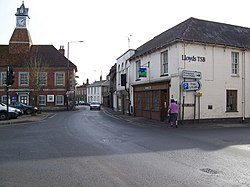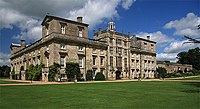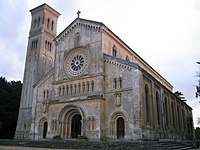Wilton: Difference between revisions
Created page with '{{Infobox town |name=Wilton |county=Wiltshire |picture=A30, Wilton - geograph.org.uk - 1129099.jpg |picture caption=Wilton |os grid ref= |latitude=51.080 |longitude=-1.864 |popul…' |
No edit summary |
||
| Line 9: | Line 9: | ||
|population=3,873 | |population=3,873 | ||
|census year=2001 | |census year=2001 | ||
|post town= | |post town=Salisbury | ||
|postcode= | |postcode=SP2 | ||
|dialling code=01722 | |||
|dialling code= | |||
|LG district=Wiltshire | |LG district=Wiltshire | ||
|constituency= | |constituency= | ||
Latest revision as of 17:57, 1 October 2016
| Wilton | |
| Wiltshire | |
|---|---|
 Wilton | |
| Location | |
| Location: | 51°4’48"N, 1°51’50"W |
| Data | |
| Population: | 3,873 (2001) |
| Post town: | Salisbury |
| Postcode: | SP2 |
| Dialling code: | 01722 |
| Local Government | |
| Council: | Wiltshire |
Wilton is a town in Wiltshire, of which it was once the county town. It is now a little place, but has a rich heritage dating back to the Anglo-Saxon period. Today it is overshadowed by its larger and more famous neighbour, Salisbury, but still has a range of notable shops and attractions, including Wilton House.
The confluence of the rivers Wylye and Nadder is at Wilton.
History
The history of Wilton dates back to the Anglo-Saxons in the 8th century AD, and by the late 9th century it was the capital of Wiltunscir, a shire of the Kingdom of Wessex. It remained the administrative centre of Wiltshire until the 11th century. Wilton was of significant importance to the church, with the founding of Wilton Abbey in 771 and a number of other establishments. In 871 Alfred the Great, a month from his accession, met a Danish army here with a small troop, losing the battle.[1]
Wilton remained a prosperous town, as recorded in the Domesday Book. The building of Salisbury Cathedral nearby, however, caused Wilton's decline, as the new site of Salisbury, with a new bridge over the River Avon, provided a convenient bypass around Wilton on the trade routes.
Wilton Abbey was surrendered to Henry VIII in 1539 during the Dissolution of the Monasteries, and in 1541 much of the estate was granted to the Earl of Pembroke, upon which Wilton House was built.

By the 17th century, weaving had become a large trade, and the carpet industry began in 1741, when two French weavers were brought in by the 9th Earl of Pembroke to teach the local people new skills. Carpet weaving prospered until 1815, when peace following the Napoleonic Wars introduced European competition. The Wilton Royal Carpet Factory was founded at the turn of the century, with the help of the then Lord Pembroke, to rescue the previous carpet factory that had fallen into financial difficulty. The carpet factory continued to operate until 1995, when it closed temporarily after a takeover. The factory re-opened, although it was unable to retain the Royal prefix.
An outbreak of smallpox in 1737 killed 132 people.[2] Local folklore claims that the outbreak was believed to be associated with the witchcraft of the four Handsel sisters, who were summarily murdered and buried in Grovely Wood.
Wilton had two railway stations. One (later known as Wilton North) was opened by the Great Western Railway in 1856 on their line from Westbury to Salisbury, and another (later known as Wilton South) opened by the Salisbury and Yeovil Railway in 1859 on the West of England Main Line from London to Exeter. The arrival of the railways led to increased prosperity. The stations closed in 1955 and 1966 respectively; the nearest station is now at Salisbury.
The headquarters of Land Forces was at Wilton, near the large number of military camps and the ranges of Salisbury Plain. (The title of HQLF has varied several times since the 1960s.)
Parish church

The Church of England parish church of St Mary and St Nicholas was built as a replacement for St Mary's Church between 1841 and 1844 at the instigation of the Countess of Pembroke and her younger son Baron Herbert of Lea, designed by the architect Thomas Henry Wyatt in the Romanesque style, with considerable Byzantine influence. For a small town, the church is enormous, representing the wealth of its benefactors.
The most notable external feature of the church is the 105-foot campanile. Many of the materials used in the church's construction were imported from Europe, including marble columns from Italy and 12th and 13th century stained glass from France.
Outside links
- Parish of Wilton
- Wilton community history
- Historic Wilton photos at BBC Wiltshire
- Church of St Mary and St Nicholas information
References
- ↑ Anglo-Saxon Chronicle Laud Chronicle (871) Ða feng Ælfred Æðelwulfing his broðor to West Seaxna rice. 7 þæs ymb i monað gefeaht ælfred cining wið ealne þone here litle werede æt Wiltune 7 hine lange on dæg geflymde 7 þa Deniscan ahton wælstowe geweald.
- ↑ Wiltshire Council. Wiltshire Community History